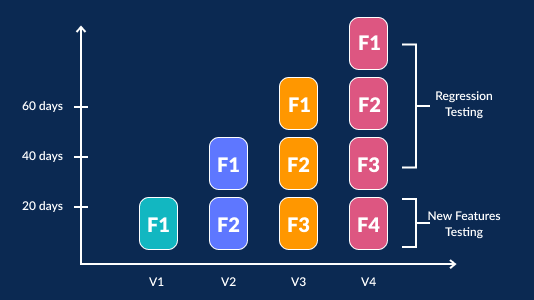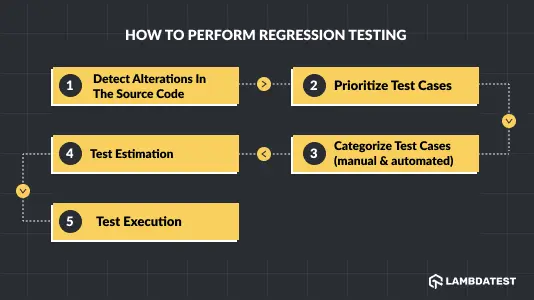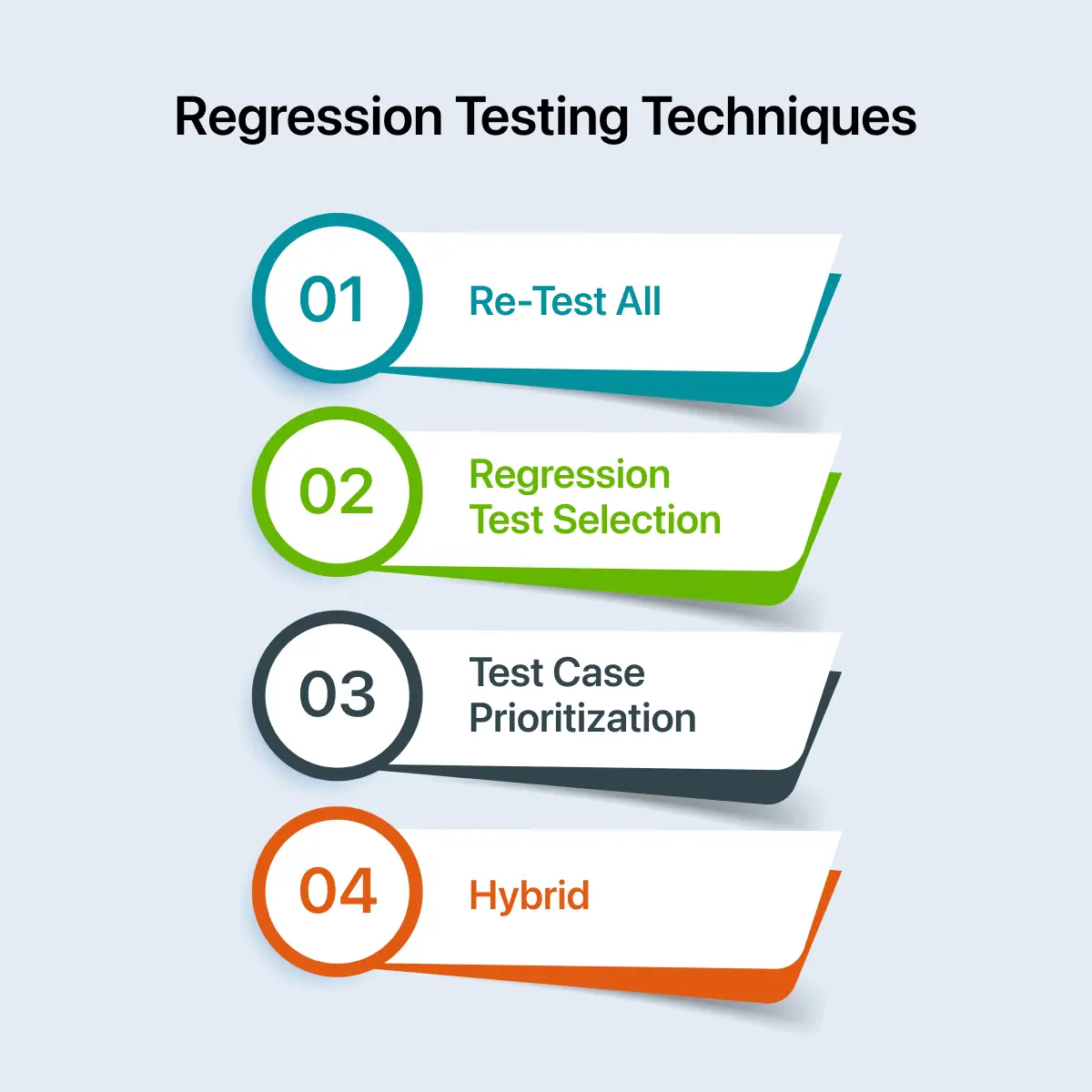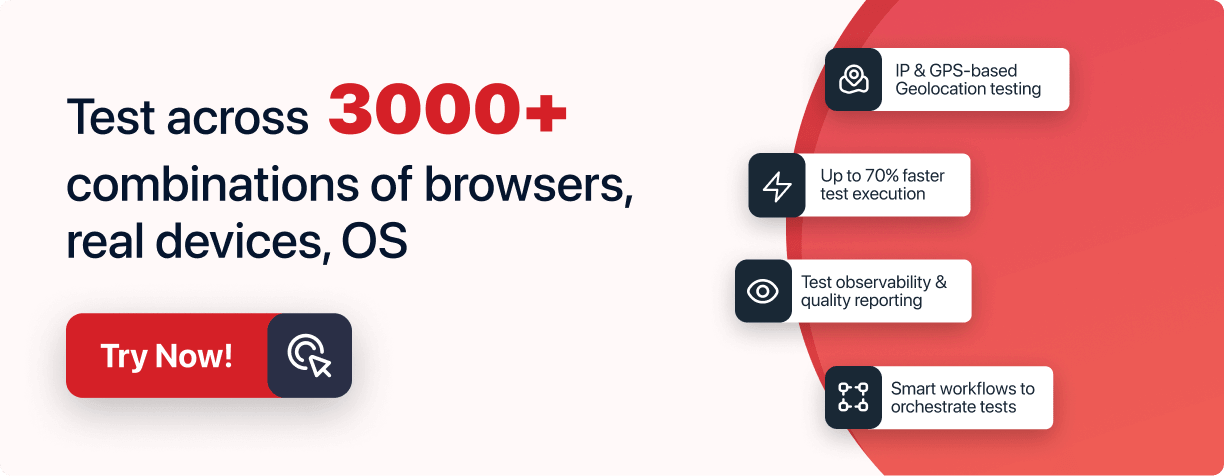Regression Testing: Tutorial With Best Practices
- Learning Hub
- Regression Testing: Tutorial With Best Practices
CHAPTERS
- Overview
- What is Regression Testing?
- Why is Regression Testing Important?
- When is Regression Testing Performed?
- Regression Testing Example
- How to perform regression testing
- How Often Should You Do Regression Testing?
- Regression Testing Tools and Frameworks
- Regression Testing Techniques
- Regression Testing vs Retesting: Difference
- How to Define a Regression Test Case?
- Regression Testing at Scale
- Why is regression testing important in Agile and CI/CD?
- Types of Regression testing
- Challenges in Regression Testing
- Best Practices for Regression testing
- Conclusion
OVERVIEW
Regression testing is a software testing process executed after making modifications or upgrades to a software application and re-tests the application areas that may have been affected by the fix. It can be performed manually and automatically by running a specific set of test cases.
Regression Testing ensures software stability after modifications. It's a repetitive testing process that verifies changes haven't negatively impacted existing functionalities. Its primary goal is to catch regressions, where updates inadvertently reintroduce or create new bugs.
When a software product undergoes alterations in the existing features, bug fixes, and the addition of new features, regression testing aims to ensure that after these alterations, the product works as expected.
In this hub further you’ll understand regression test meaning, importance of regressions tests, how to run regression tests and much more.
Let’s get started !
What is Regression testing?
Regression testing is the process of re-evaluating a software application after changes have been made to ensure that existing functionalities remain intact, and it is called Regression Testing.
In the software development lifecycle, regression testing is an essential stage that verifies that recent code modifications haven't negatively impacted an application's current functions. Ensuring that no new flaws have been introduced and that the program continues to work as intended requires methodically rerunning previously executed test cases on the updated codebase.
When a new build is to be validated, the testers do the functional testing to verify the modifications in the existing and newly added functionality. After this testing gets completed, the testers proceed with regression testing. They find out whether the new improvements have caused any functionality defect in the working that was satisfactory before the latest alterations.
One of the most important aspects of quality assurance is establishing strong regression test procedures, which guarantee that software is developed with the utmost reliability and integrity throughout the whole development process.
Why is Regression Testing Important?
To make sure that new and old functionality coexist peacefully, regression testing is important, anytime new code is added or defects are corrected. The possibility of dependencies between several code segments makes this quality check crucial. It is especially crucial for last-minute system changes as it ensures that the original code is not impacted.
Continuous enhancements or alterations in the product can potentially disrupt previously tested code, leading to unforeseen bugs. Failing to test such code changes may result in critical issues in the live environment, causing inconvenience for the customer.
Let us consider an online website. You report an issue that the cost of a product for sale is not getting displayed correctly, that is, a lesser price is replacing the actual cost of a product. You conclude that this issue must be fixed as soon as possible.
Now, a developer has fixed this issue. At this juncture, it is feasible that the price on the reported page has been changed, but the summary page still has the erroneous cost, and the email sent to the client also has the wrong cost. This proves that after the bug fix is completed, the page that displayed a lesser price must be checked, and the related pages must be checked. This shows why it is crucial to run regression tests.
The below graph shows the importance of running a regression test.

When is Regression Testing Performed?
Every scenario that involves alterations in the production code necessitates regression tests. All the following scenarios have the requirement for this testing.
- Addition of new functionality to the application: A website having login functionality. Users can use this functionality only with email. A new feature is to perform login using Facebook credentials.
- Requirement for change: An example is removing the Remember Password functionality, which was previously applicable.
- Fixing a defect: A Login page on which the Login button is not functioning correctly. A tester provides a report that there is a bug, which is that the Login button is broken. Once developers fix this bug, a QA engineer performs a test, ensuring that the Login button is working as expected. At the same time, the tester tests other functionality that is pertinent to the Login button.
- Performance issue fix: An example is that the home page needs five seconds to load. Now, this duration is decreased to two seconds.
- Modification in the environment: An example is when the database is changed from MySQL to Oracle.
- Long Development Cycles: Some software products require several months for completion. So for these products, regression tests are recommended daily. Some releases are done every week. In the case of such products, regression tests begin after the functional testing is over.
Regression Testing Example
Let us assume that there is a software product XYZ. One of the functions is to trigger the dispatched, acceptance, and confirmation emails when a user clicks the Dispatch, Accept, and Confirm buttons. During development, the confirmation email develops some issues.
To fix these issues, the Developers make some code changes. In this process, it is evident that the confirmation emails must be tested. Moreover, the dispatched and acceptance emails should also be tested to verify that the code alterations have not impacted them.
Regression testing in this example would be immensely helpful in ensuring that the code changes made to fix the confirmation email issues do not inadvertently affect the dispatched and acceptance emails. By systematically running regression tests, you can verify that all three types of emails (dispatched, acceptance, and confirmation) still function correctly after the code alterations. This provides a safety net to catch any unintended consequences of the fix, ensuring that the entire email triggering functionality remains intact and reliable.
Automate your test scripts across 3000+ browser environments Try LambdaTest Now!
How to perform regression testing?
Every organization uses a different strategy or Regression Test Suite. Nonetheless, the majority adhere to a few basic steps, which are as follows:

Detect alterations in the source code
Carefully find and examine source code optimizations and alterations in this step. Subsequently, a comprehensive evaluation of the impacted components and their influence on the key elements of the product are conducted.
Prioritize Test Cases
Choose specific test cases that cover the critical functionalities of the application. These test cases should represent typical user actions and how they interact with the software. Prioritize the most important test cases based on their impact on the system.
Test Estimation
Test estimation in regression testing involves determining how long it will take to execute the entire suite of test cases. This helps in planning resources and schedules effectively for a comprehensive regression testing process.
Categorize test cases (manual & automated)
Testers should select between manual and automated testing based on the number of test cases once they are done with time estimation.
Test Execution
Finally, all test cases are executed in the order of priority to find defects and ensure that the application is working correctly. Test execution is the phase where pre-defined test cases are run against the updated codebase to ensure that new changes haven't introduced any regression issues.
How Often Should You Do Regression Testing?
Deciding the frequency of performing regression test is important for keeping your software stable and reliable. The frequency depends on factors such as the size, the complexity, and more of the application. The below points will help you decide how often you should do regression testing:
- After Significant Changes: Whenever significant changes are made to the software, regression test should be conducted. This includes major updates, enhancements, or modifications to the application. Significant changes can introduce unexpected issues or regressions, making it essential to test the existing functionalities to ensure they remain intact.
- Before Major Releases: Regression testing should be done before each major software release. Performing regression tests for major releases, such as new features, significant updates, and bug fixes, helps identify any regressions that may have been introduced during the development or integration process.
- Repeatedly During Development: In the development process, regression tests should be performed at regular intervals. It can be conducted after each sprint or development cycle. This ensures that any changes made during the cycle do not impact the previously tested functionalities and helps catch regressions early in the development cycle.
- After Bug Fixes: After fixing the bugs, regression testing should be performed to validate any unintended side effects or regressions in other areas of the software. This is essential in case of critical or high-priority bugs that can significantly impact the overall system functionality.
- Periodic Maintenance Testing: Conducting periodic regression test as part of software maintenance is crucial even after no recent product changes exist. This helps identify any hidden regressions that may have emerged due to system updates, patches, or changes in the underlying infrastructure.
- Automate Continuous Regression Testing: Consider implementing automated regression testing as part of your continuous integration and deployment processes. This enables running regression tests automatically whenever code changes are committed or deployed. Continuous regression tests ensure ongoing stability and reliability to catch regressions early in the development lifecycle.
Remember, the frequency of regression testing may vary based on the unique characteristics of your software project. By assessing the risks, complexity, and criticality of the application developers can determine the optimal frequency of regression testing.
Regression Testing Tools and Frameworks
Selenium: Selenium is a leading tool for cross-platform regression testing, specializing in web application automation. It supports data-driven testing and is ideal for large-scale teams with experienced testers.
Playwright: Playwright is a flexible tool that works with several browsers and is useful for regression testing web applications.
Puppeteer: Similar to Playwright, Puppeteer is proficient at doing regression testing on web applications in a variety of browsers.
Appium: Appium plays a key role in regression testing iOS and Android apps to guarantee maximum functionality.
LambdaTest: LambdaTest is a cloud-based platform that provides a suite of testing solutions, including regression testing. It allows you to perform cross-browser testing on a wide range of browsers and operating systems, ensuring that your web application functions consistently across different environments. With LambdaTest, you can automate your regression tests, run parallel testing, and even perform AI - Powered visual regression testing to identify any visual discrepancies across browsers. This helps in ensuring that code changes do not introduce unintended issues, making LambdaTest a valuable tool for regression testing in web development projects.
Katalon: If your user community for test automation is large, this is the preferred choice among the tools. It is an all-in-one platform. You need not have a complicated setup for this tool. It is a readymade framework that renders codeless and free solutions.
Watir: The complete name is web application testing in Ruby. The Ruby programming code is used to create this open-source library. Using this, you can write tests that can be easily read and maintained on a flexible, lightweight UI. Watir endorses disparate user interaction abilities for testing websites, such as validating texts, entering data in forms, and clicking links.
Apache JMeter: This is open-source software for test automation. It can measure test performance and load functional test behaviors. It can render an entire Regression test suite for end users. It supports performance and load tests on disparate servers, applications, and protocols.
Ranorex Studio: This has an inbuilt Selenium WebDriver. It can be used for automated regression testing of mobile, web, and desktop apps. The studio is inclusive of complete IDE plus tools to perform codeless automation.
Regression Testing Techniques
The following are techniques used in regression tests: Test case prioritization, Regression test selection, Re-test all, and Hybrid.

Re-Test All
You have to re-execute all the test cases in the test suite. This is to ensure that the alteration made in the code has not introduced any bugs. This type needs more time and resources than the other techniques. This is the most expensive technique.
However, it is the most secure method because it ensures that all the bugs have been identified and fixed. This method is generally applicable when there is a major update in the operating system, or the application is modified for a new language or platform.
Regression Test Selection
Based on the code modification in the module, you can choose some test cases from the test suite. Then, you re-execute these selected test cases. The entire test suite need not be re-executed. The test cases are categorized into two types: obsolete test cases and reusable test cases.
In the upcoming regression cycles, you should not execute the obsolete test cases but must execute the reusable ones. In this technique, you are implementing only the relevant test cases, which are limited in number. This decreases the time and effort of the regression test.
Test Case Prioritization
Every test case is assigned a priority based on the criticality of the case, the impact on the product, and the frequency of the specific functionality of the product. The test cases of newly added functionalities and customer-facing aspects are in the high-priority category. Those with high priority are executed first. Those with medium priority follow these, and lastly, those with low priority are implemented.
Hybrid
This technique is a blend of test case prioritization and regression test selection. The complete test suite is not re-executed. Based on priority, you have to select test cases for re-execution.
Regression Testing vs Retesting: Difference
Here's a detailed comparison between retesting and regression testing:
| Retesting | Regression Testing |
|---|---|
| Ensures bug-free and flawless execution of test cases after fixing bugs. | Ensures code functionality remains unaffected after adjusting or modifying the application. |
| Performed for failed test cases. | Performed for passed test cases. |
| Fixes the original bug in the build. | Tests for unintended changes or outcomes in the code. |
| Automated retesting is not possible. | automated regression testing is possible. |
| Also known as planned testing. | Also known as generic testing. |
| Usually cannot be performed in parallel with regression testing due to high priority. | It can be performed in parallel with retesting in some cases, based on lower priority and resource availability. |
| Doesn't include bug verification as a part of testing. | Includes bug verification as a part of testing |
| Performed across all software releases. | Performed across a few latest versions of the software. |
| Less time-consuming. | More time-consuming as it involves a detailed analysis of previous software versions' issues. |
How to Define a Regression Test Case?
Ensuring the smooth release of software involves selecting the correct test cases while performing regression testing. New bugs can even arise after making changes or fixing the code. Hence, performing regression testing with the correct test cases is crucial before launching the product.
Given below are some types of test cases that you should include in your regression test suite:
- Frequently failing defects: Choose test cases that cover the issues that have happened often in the past. These are the areas where you might find the bugs again.
- Recent testing defects: This category includes test cases that address the issues found during the most recent testing phases. By testing those areas again, you can be sure that the fixes worked and didn't cause any new problems.
- Priority 1 and Priority 2 test cases: With this test case, developers can prioritize the important test cases that check critical parts or features of the product. These areas need thorough testing to maintain the product's quality.
- Core features or functionalities: This category includes test cases focusing on the core features or functionalities of the product. These factors play a vital role for the product to work properly.
- Integration test cases: The integration test cases choose test cases covering how different parts of the product work together. This ensures that everything fits together nicely.
- Complex test cases: Include test cases that test out tricky situations, special cases, or challenging inputs. These help find any potential issues in the more complicated parts of the software.
- Test cases for modified modules: Pick test cases that specifically target the parts of the product that have been recently changed. This makes sure that the changes didn't introduce any new problems.
- Frequently used functionalities: Consider test cases that cover the things that users do most often with the product. These are the areas where any issues can have a big impact on the user experience.
By including the above-suggested test cases, developers can improve their chances of finding bugs early on and ensure a smooth release of their product.
Regression Testing at Scale
The importance of integrating regression testing into the Software Development Life Cycle (SDLC) and highlights the need for collaboration between different teams. While individual teams may conduct software regression testing independently, it is crucial to avoid working in isolation. Instead, setting up standardized processes and incorporating regression testing as a long-term goal is essential for achieving scalability in the development process.
When aiming to scale up, it's important to carefully consider some factors and ensure that software regression testing is seamlessly integrated into the broader development framework. This ensures that testing efforts are synchronized and aligned with the overall goals of the project.
Some other factors to consider:
Automated Testing: Automated regression testing is crucial for identifying regression bugs promptly due to increased speed and frequency.
Timely Issue Identification: Detecting issues early prevents defect leakage into the product/application in later testing stages.
Parallel Testing: This approach provides rapid feedback, allowing teams to generate test results across various environments, browsers, devices, and operating systems.
Data Migration: When importing legacy data from an older system to a newer one, parallel tests ensure seamless data transfer using an automated regression test suite.
Why is regression testing important in Agile and CI/CD?
Because Agile and CI/CD environments are iterative and fast-paced, regression testing for software is essential. It ensures that updates to the code don't unintentionally introduce bugs or disrupt current functionality. Teams can ensure code integrity, detect problems early, and confidently release changes by automating these tests. This supports the ideas of Agile development and saves time and resources by enabling prompt adjustments to changing requirements.
Regression testing is essential in Continuous Integration/Deployment (CI/CD) pipelines where code is continuously integrated and deployed. It enables continuous delivery by guaranteeing the stability and dependability of each deployment. Teams can reduce human overhead by concentrating on more complicated and exploratory testing by automating these tests. Regression testing also encourages teamwork since it gives them confidence in the codebase's stability, which facilitates a more efficient development process and effective software delivery.
Types of Regression testing
You can implement various regression tests depending on the feature or update you aim to deploy. However, it is crucial to understand the several regression test types to choose the right one.
Regression testing is of the following types.
- Complete or Full Regression
- Partial Regression
- Unit Regression
- Corrective Regression
- Selective Regression
- Re-test Regression
You should opt for this type when there is an alteration of code on many modules, and the impact of this alteration on the other modules is unknown. So, the decision is to check the entire product to detect whether there are any other modifications originating due to the changed code.
For the second product release, the client suggests adding four or five new features and some defects from the first release are to be fixed. The testing team implements an impact analysis and concludes that the entire product must be tested for these modifications. In a nutshell, this type implies testing all the altered and old features.
Let us consider a Java application with Java Virtual Machine (JVM) as the root file. The Java application must be tested if a change is essential for the JVM file.
Partial Regression
After developers make some code changes, the unit of this changed code is integrated with the existing (that is, unchanged) code. You have to verify whether the changed code works as per expectations.
Unit Regression
You have to do this while the unit testing phase is in progress. In this case, the code of a unit is tested in isolation. The goal of this type of testing is that the unit has to be tested at an individual level. So, there is blocking of all the dependencies on the unit being tested.
Corrective Regression
It is one of the simple regression tests requiring less effort. Corrective regression test involves zero changes to the existing codebase and adding new functionality to the software application. You need to test the existing functionality and the test cases that go with it rather than developing new ones.
Selective Regression
Selective Regression test determines the impact of the existing codebase and both new and existing code. Common elements like variables and functions are implemented into the application to identify results without affecting the entire process.
Re-test Regression
Re-test regression involves re-executing all the test cases to ensure no defects due to code alterations in the software. This type of testing needs more manual effort from the QA side.
Challenges in Regression Testing
Regression tests help unearth bugs while introducing new features or in an existing codebase and mitigate app failures and performance bottlenecks.
However, while running a regression test, the following are a few challenges testers face.
Test suite cost and time: A regression test suite needs continuous improvement when deploying new features. Therefore, the number of test cases varies, and new tests must be re-tested with older tests, which require a lot of time to complete.
Incorporating parallel testing can be a feasible solution to run test cases concurrently across multiple browsers and OS combinations.
Complex test cases: As the software project becomes more intricate, the number of test cases and their complexity also rise, consuming a lot of time and resources.
Maintenance: As the application size grows, the complexity of test cases in regression test suites increases. Therefore, proper maintenance is crucial to tackling the complexity and test execution time.
Best Practices for Regression testing
In this section, let’s look at some of the best practices for running regression tests.
- With the introduction of newer features or upgrades, keep your test suites up to date. Also, add tests to check whether the old feature is working.
- Check for the features used by end-users, and test them to check if that specific functionality is working as intended.
- Incorporate regression testing frameworks to reduce additional maintenance.
- Update your test design specification as per the requirements of developers and testers.
- Invest in smart testing use available tools like "Test At Scale" by lambdatest TAS can intelligently select and execute only the tests impacted by code changes, leading to up to a 95% reduction in testing durations. This not only accelerates the entire development pipeline but also ensures that developers get the same test results faster. With features like Flaky Test Management Pipeline and automated triaging, TAS is designed to enhance developer productivity and confidence, allowing them to ship code more frequently.
The number of test cases will grow as your application becomes more complex. Hence, you need a cloud-based testing solution that scales with your testing requirements.
Platforms like LambdaTest offers a cloud-scalable infrastructure of 3000+ real browsers, devices, and OS combinations for your automation regression testing needs.
With LambdaTest, you can leverage the capabilities of the online Selenium Grid to run thousands of parallel tests in a go, thereby cutting down your execution time and getting faster feedback on code commits.
Subscribe to our LambdaTest YouTube Channel to get the latest updates on tutorials around Selenium testing, Cypress testing, and more.
Conclusion
Regression testing enables the delivery of a high-quality product and user experience. The primary benefit of regression testing is that any code change does not impact the existing functionality.
You can automate the regression test cases by selecting an automation tool based on project requirements and its ability to update the test case suite because the frequent update of the test case suite cannot be avoided. After choosing the apt tool, you can leverage it to detect all surfaced bugs and get rid of them early in the pipeline.
When regression testing is coupled with the Agile methodology, the outcome is that there are many technical and business benefits. The more time and money invested in regression testing, the more control of the process, error handling, and budget.
Frequently Asked Questions (FAQs)
What are the 3 techniques of Regression testing?
The below three techniques can be used to run regression tests.Run re-test for all test cases, Select test cases. Prioritize regression test cases.
What is meant by regression testing?
Regression testing is the process of executing tests after making modifications or upgrades to a software application and re-tests the application areas that may have been affected by the fix.
What is a regression in QA testing?
Making adjustments to the software and code of your digital product can lead to unforeseen outcomes. In software QA, regression testing involves examining the software following a development phase to verify that all functionalities operate as planned.
What is regression vs UAT?
Regression testing is a continuous process. It involves testing whenever changes are made to the code. User Acceptance Testing (UAT) happens at the end of the testing phase, just before the product is ready to be released.



